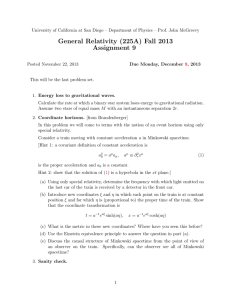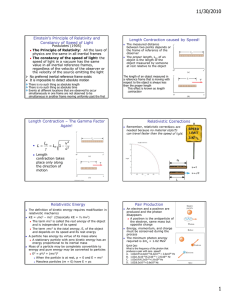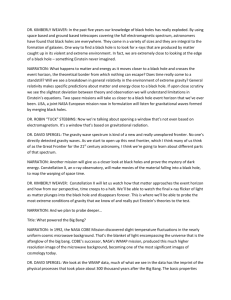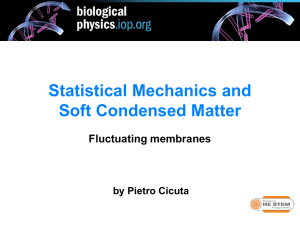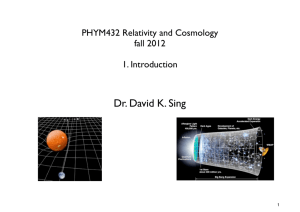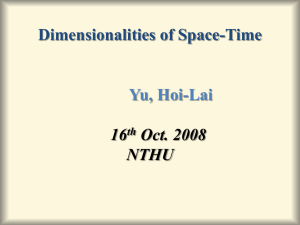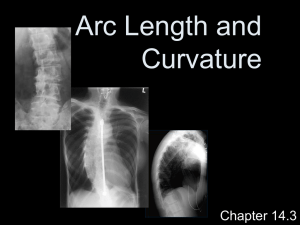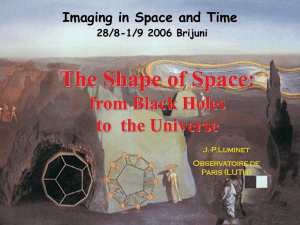here
advertisement
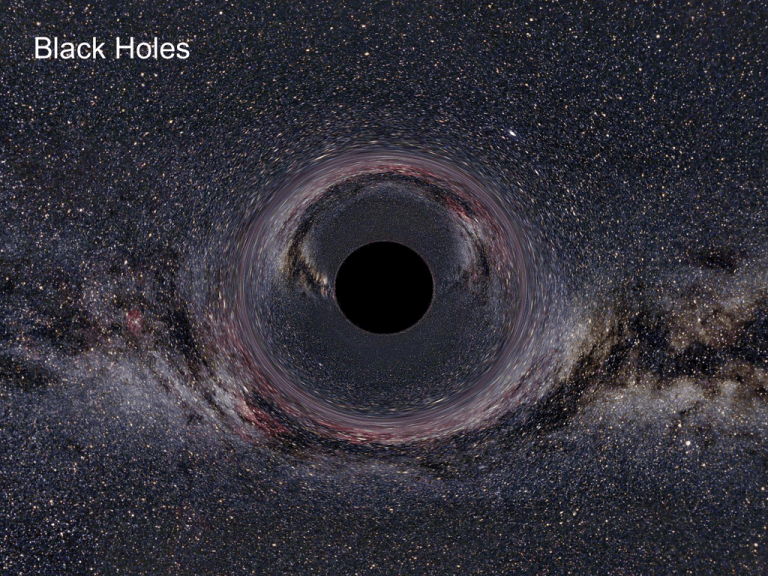
Black Holes Underlying principles of General Relativity The Equivalence Principle No difference between a steady acceleration and a gravitational field Gravity and Acceleration cannot be distinguished V = a h/c h Equivalence principle – this situation should be the same h Gravitational field Eddington tests General Relativity and spacetime curvature GR predicts lightbending of order 1 arcsecond near the limb of the Sun Principe May 1919 Lensing of distant galaxies by a foreground cluster QSO 2237+0305 The Einstein cross Curved Space: A 2-dimensional analogy Flat space Radius r Angles of a triangle add up to 180 degrees Circumference of a circle is 2πr Positive and Negative Curvature Triangle angles >180 degrees Triangle angles <180 degrees Circle circumference < 2πr Circle circumference > 2πr The effects of curvature only become noticeable on scales comparable to the radius of curvature. Locally, space is flat. A geodesic – the “shortest possible path”** a body can take between two points in spacetime (with no external forces). Particles with mass follow timelike geodesics. Light follows “null” geodesics. Time Timelike Curved geodesic caused by acceleration OR gravity Spacelike Matter tells space(time) how to curve Spacetime curvature tells matter how to move Space ** This is actually the path that takes the maximum “proper” time. Mass (and energy, pressure, momentum) tell spacetime how to curve; Curved spacetime tells matter how to move A formidable problem to solve, except in symmetric cases – “chicken and egg” Curvature of space in spherical symmetry – e.g. around the Sun V = (2ah)1/2 h Special Relativity A moving clock runs slow Observer ON TRAIN Observer BY TRACKSIDE Train speed v Width of carriage s d Is d meters vt/2 t’ = 2d / c t = 2s / c So t’ is smaller than t Observers don’t agree! Speed of light is c=300,000 km/s Smaller by a factor g Where g2 = 1/(1 - v2/c2) V = (2ah)1/2 h Special Relativity A moving ruler is shorter According to the equivalence principle, this is the same as h Gravitational field Curvature of space in spherical symmetry – e.g. around the Sun Spacetime curvature near a black hole A black hole forms when a mass is squashed inside it’s Schwarzschild Radius RS = 3 (M/Msun) km Time dilation factor 1/(1 – RS/r)1/2 Becomes infinite when r=RS Progenitor < 8 M Planetary Nebula Remnant < 1.4 M The Chandrasekhar limit A cooling C/O core, supported by quantum mechanics! Electron degeneracy pressure. Cools forever – gravity loses! White Dwarf Progenitor > 8 M Remnant < 2.5 M Supernova Remnant > 2.5 M 20 km Neutron star, supported by quantum mechanics! Neutron degeneracy pressure. Cools forever – gravity loses! Black Hole – gravity wins! Black Holes in binary systems Cygnus X-1 M3 sin3i = 0.25 (M + m)2 Period = 6 days M > 5 Msun Ellipsoidal light curve variations Depend on mass ratio and orbit inclination Combine ellipsoidal model with radial velocity curve BH mass Black hole mass 10 –15 x Msun Spinning black holes – the Kerr metric Spaghettification A 10g stretching force felt at 3700 km (>RS) from a 10 Msun black hole Force increases as 1/r3 Supermassive Black Holes Jets propelled by twisted magnetic field lines attached to gas spiralling around a central black hole Supermassive Black Hole in the Galactic Centre Mass is 4 millions times that of the Sun Schwarzschild radius 12 million km = 0.08 au Falling into a black hole
